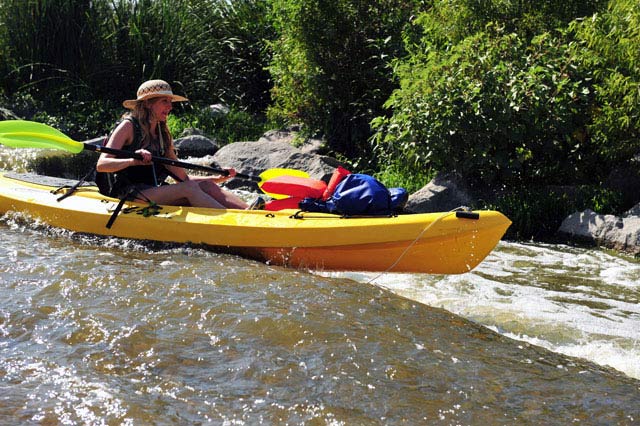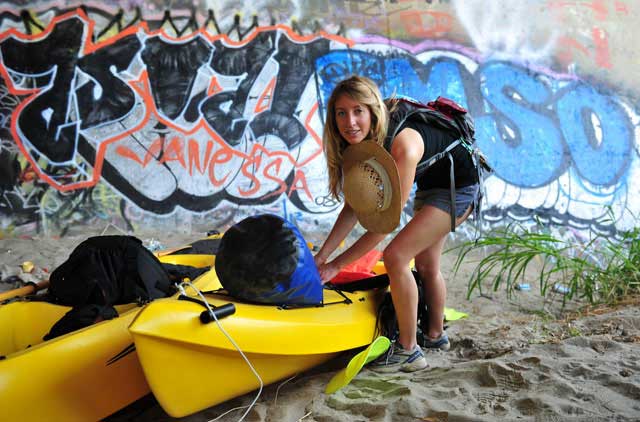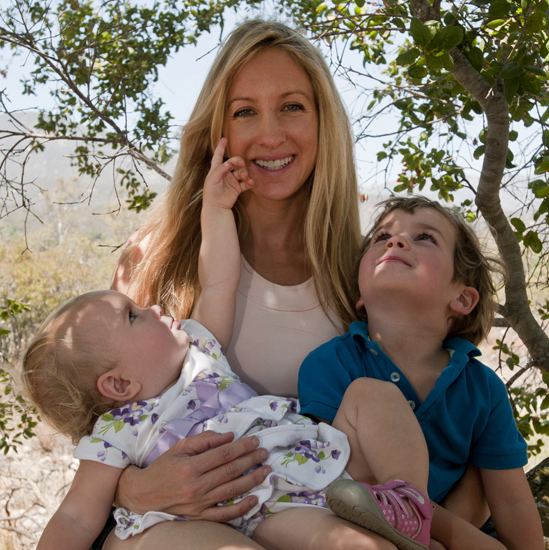Many Angelenos recognize the Los Angeles River as an urban treasure, with bike trails, kayak tours, parks, and plans for major revitalization. The award-winning documentary Rock the Boat -- Saving America's Wildest River tells the story of a 52-mile kayak trip, masterminded by Heather Wylie -- a trip that helped save our river. Heather is a former civilian biologist with the U.S. Army Corps of Engineers, a young mother, and an inspiring activist. Here she talks with us about her disillusionment with the Army Corps of Engineers, saving rivers, and why she paddled down the river.
 Photo credit: Tom Andrews
Photo credit: Tom Andrews
Why does floating down the Los Angeles River in a plastic boat matter?
I was hoping that as people wondered, "Why is that little woman kayaking down the river?" I would draw attention to the urgent need to defend it.
The 2006 Bush-era Supreme Court decision in Rapanos made it easier for the Army Corps of Engineers and other agencies to roll back the protections of the Clean Water Act. Rapanos was an interesting case where a developer filled several acres of wetlands in Michigan to build a mall, and did it without a permit, so the Environmental Protection Agency and Army Corps took out an enforcement case against him. The ruling had huge implications, and we were being issued a new set of guidelines in response to the ruling; if a water body is 'navigable in-fact,' the river and the waters feeding into it are much more likely to retain their Clean Water Protections. If we could prove that boats could travel its full 52-mile length, then the Los Angeles River and its headwaters would retain their protections. If we couldn't, then creeks and wetlands in the watershed were at risk from losing their legal protections.
Why the need for publicity?
The public has relied on the Clean Water Act to protect their waters for drinking, swimming, and fishing. Our right to clean water shouldn't depend on whether someone can kayak down a river but -- thanks to the Supreme Court's 2006 decision -- now it does. I was hoping our boat trip would not only stop Clean Water Act rollbacks in the L.A. River system, but would get people to put pressure on Congress to step up and do its job restoring the Clean Water Act to its original intent.
How did you become aware of the problem?
The Clean Water Act is broken into different sections. Under Section 404, the U.S. Army Corps of Engineers can issue permits to permanently destroy waters of the United States. This is often through putting fill into rivers, for instance, while building large developments, or by filling wetlands and streams, or by narrowing floodplains and building levies, or by cutting the tops of mountains for mining. Pollutants such as from sewer treatment plants or discharge waters are regulated by a different section of the Clean Water Act. The Army Corps are supposed to require that applicants avoid these impacts, but the Corps rarely do anything but rubber stamp the destruction of our waters.
When did you realize our water protection was threatened?
When I started working at the ACE, I assumed the Corps was doing their best to follow the Clean Water Act. Two to three years into working there, I got handed an application for a project to fill in vernal pools to build a sports warehouse. Typically, endangered species live in vernal pools, which dry up during warm months. They provide hostile conditions for most living organisms -- organisms have to really specialize to survive there. Many vernal pools have been filled; they are very shallow, so it's easy to plow them down. The few vernal pools left are very important to protect.
My applicant had a 10-acre site and wanted to fill a vernal pool that included a federally listed endangered species even though he had planned three acres of landscaping and plenty of room to avoid the pool. His application couldn't pass what we called the 'straight face test,' but in spite of my objection and the objections of the Environmental Protection Agency's wetland science expert, my boss decided to declare it not a vernal pool to make it easier to grant the permit. He removed me from the project, and I realized my agency was more interested in helping developers than in upholding the intent of the Clean Water Act.
Where did that realization lead?
I knew my time at the Corps was limited because I actively objected and made myself very known. I wanted to go out with a big impact. Right after this, the Rapanos guidance came out. I found out that the Corps was taking this opportunity to roll back protections on even more waters than the Supreme Court's ruling required. Some of the first big decisions being made were on the L.A. and Santa Cruz Rivers, and like dominoes falling, these decisions would set the precedent for rulings over other rivers. I stayed at work really late and dug through the network drives and leaked the plans to environmental attorneys and journalists, along with an explanation of case law and details.
I contacted Henry Waxman, who represented the area and was also Chair of the House Oversight Committee. He put pressure on the EPA and the Army Corps and started a congressional inquiry. In the meantime, I decided I needed to promote awareness that clean water protection is being eroded away -- by boating down the Los Angeles River.

Photo Credit: Tom Andrews
How did you know you could kayak on the river?
I looked for someone with kayaking experience -- I dug on the internet and saw George Wolfe's comedy video, where he is stuck in traffic and sees a kayak for sale, gets out of car in his business suit and briefcase, and paddles to work. I realized he had actually kayaked on the river, so I contacted him through YouTube. I also found Marcus Erikson, who specializes in the effects of plastic pollution on oceans and waters. He had made a coke bottle kayak and paddled it down the L.A. River, and he made a giant sailboat from coke bottles and sailed to Hawaii. I was scared because I had put myself on the line trusting strangers -- boaters, reporters, and congressional and environmental attorneys from countless groups. I didn't want to get fired before we had brought attention to the issues. I didn't want to get locked out of our computer system or have surveillance installed.
It took months to plan our trip. Had I not found George Wolfe, and been supported by environmental advocates, and by Henry Waxman, this trip might have been impossible. This was an amazing group of people, and I loved getting to know them; they recognized the larger importance of protecting all of our waters, not just this river.
How long did the trip take?
The trip took three days. I believed that the California Constitution protected my right to be in the river without a permit, but the Army Corps did not agree. We were stopped a few times. People are afraid to be arrested claiming their rights, but I would argue that it is the only morally correct thing to do -- when you see government acting improperly, take a stand against it.
Did you enjoy the trip?
The boating was really fun -- it was a totally different kind of river trip. Anyone who will jump in a boat is a pretty stand up person. Although the river is primarily a concrete channel, it surprisingly feels like being on a natural river. You look up and see mountains in the backgrounds, and there are rocks and vegetation and ripples and fish and birds and people biking by, the weather was great. It was a great experience.
You lost your job. What kind of person takes on the government -- at the expense of her own job?
I think being able to recognize injustice and being able and willing to take personal responsibility for addressing it.
Is it too late to save rivers?
Not at all, there are pristine rivers that should not be degraded. In Arizona, for example, the controversial Rosemont mine proposes chopping a massive slice of mountain and discharging copper slurry into very pristine waters.
We need to restore damaged watersheds too. The L.A. River will never look how it originally did, but it could become a lot more useful. Restoring the watershed is critical. During the 100-year storm events, which are the big floods, the river bursts out of its concrete edges. The Army Corps wants no trees or bushes in the channel that would slow the river during floods and cause even more water to overflow the banks. But if we captured and reabsorbed the water into our watershed, we could help meet our own water supply needs and reduce pollution flowing to the ocean. And we could reduce the 100-year peak flows enough to restore sections of the river to a more natural state that millions of people could enjoy.
What do you want for your own young children?
I grew up in Michigan, playing in woods and creeks, bringing home snakes and frogs. My parents would let me observe my finds for three days before I had to return them. I would love to see the L.A. River accessible to children with guided boat trips, and children using the river as a lab for chemistry and biology experiments. Children could volunteer to clean the river, restore habitats, and bond with nature.
I've dragged my children all over, breast-feeding them while lobbying and at public hearings, so they are not freaked out by these settings. I want to raise independent thinkers who fiercely love the natural world, who recognize injustice and stand up for what they believe. I hope teachers and parents reads Richard Louv's Last Child in the Woods: Saving Our Children From Nature Deficit Disorder, and take children outside to engage with nature -- otherwise why will kids care about preserving it?

Photo Credit: Ariell Brown, www.ariellbphoto.com
For information about the Los Angeles River, including history, plans, and recreation options, see http://www.lariver.org/